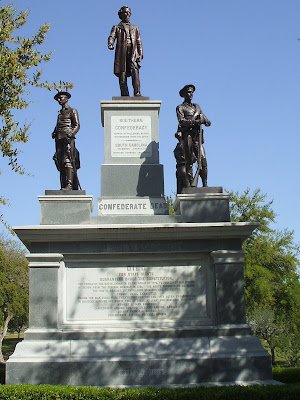A gorgeous day in Austin and a statue in front of the Capitol.
The proud and beautiful Texas State Capitol.

Ann W. Richards Congress Avenue Bridge is home to the world's largest urban bat colony, which is composed of Mexican Free-tailed Bats. The bats reside beneath the road deck in gaps between the concrete component structures. They are migratory, spending their summers in Austin and the winters in Mexico. According to Bat Conservation International[1], between 750,000 and 1.5 million bats reside underneath the bridge each summer, whereas Austin's population is about 750,000, so, there are more bats than inhabitants in Austin during the summer.

The nightly emergence of the bats from underneath the bridge at dusk, and their flight across Lady Bird Lake primarily to the east, to feed themselves, attracts as many as 100,000 tourists annually. Tourists can see the bats from the bridge, from the sides of the river and even from special boats.A study made in 1999 concludes that the economic impact of the bats to Austin city is $7.9 million each year. Today, businesses are using the bats as a symbol for Austin. A project, called "Bats and Bridges", has been put in place by the Texas Department of Transportation, in cooperation with BCI, to study the best way to make bridges habitable for bats.

And so I sat swary and tired on a little dock watching the sun go down and the bats emerging from under the bridge forming a hungry cloud.

Beautiful and unexpected Austin.

A pretty House from another aera.

Laguna Gloria is the former home of Clara Driscoll Sevier and site of a 1916 Italianate-style villa on the shores of Lake Austin in Austin, Texas. It was the original home of the Austin Museum of Art and still houses some of its collections. Today it is listed in the National Register of Historic Places.

In 1914 the property was purchased by Hal Sevier, editor of the Austin American, with his new wife Clara Driscoll. They completed their villa two years later, inspired by a honeymoon visit to Lake Como in Italy. Clara, an avid gardener, spent many years planting native and foreign plants around the site and designing the terraced gardens that remain to this day. In 1943 Driscoll donated the homesite to be used as a city museum.

In 1961, the site was converted to the Laguna Gloria Art Museum and became an important part of the Austin arts scene. Soon after, the museum began offering art classes, and in 1983, a 5,300-square-foot (490 m2) facility was built specifically for the growing art school.In 1992, the institution changed its name to the Austin Museum of Art, and four years later, moved its primary exhibition space to 823 Congress Avenue, in the heart of downtown Austin. Laguna Gloria remained the site of The Art School, and in 2003, the Driscoll Villa was renovated and again became an exhibition space, focusing on local and regional artists.


No comments:
Post a Comment